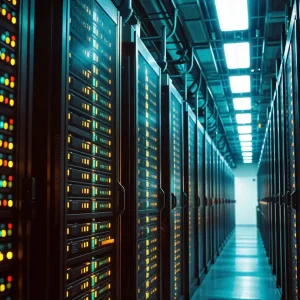
For the most part, the protestors gathered outside the Royal Dublin Society building looked entirely what you’d expect for an anti-data centre protest: an assembly of placard-wielding, anorak-sporting, woollen hat-wearing citizens who, in their minds and those of many passers-by, were fighting the good fight for Ireland under cold and grey November skies. That is, apart from Ceara Carney. An actress on the Dublin stage, Carney had swapped the typical uniform of the environmental activist for a green cape, a cardboard broach and a crown of mistletoe and berries. Her part that day was Ériu, goddess-matron of Ireland, angered at the plundering of her country’s meagre national resources for the flimsy cause of commerce.
“With the expansion of data centres, we face blackouts or importing fracked gas, which is damaging to other communities,” Carney tells Tech Monitor from the warmer environs of her living room. “We should be using our limited energy resources carefully, or it will be normal people in Ireland that pay the price. There needs to be a pause on this [new data centres] until we have more renewable energy in Ireland than fossil fuels.”
Carney’s call and those of so many other protestors for a data centre moratorium comes at a delicate moment for the Irish economy. Recent years have seen tech giants swarm to Ireland’s low-tax marketplace like wasps to a picnic, so much so that the tiny isle perched at the razor’s edge of the North Atlantic is now the world’s third-largest market for hyperscale data centres. That, in turn, has helped support a national IT services industry worth £39bn and accounts for a whopping 21% of the country’s electricity consumption. That burden is set to rise: by 2027, it is estimated that data centre power needs will exceed those of all the households in Ireland, prompting dozens of server barns to seek separate connections to the country’s natural gas network to avoid future brownouts.
This insatiable appetite for energy, critics say, is an unacceptable threat to the country’s climate change targets. “Government policy has facilitated unchecked growth of data centres which has put our electricity system at huge risk and defies our own climate laws,” Friends of the Earth campaigner Rosi Leonard told The Irish Examiner. Former Green Party politician Eamon Ryan has been equally scathing, pointing out that the contracts Gas Networks Ireland has been signing with new data centre operators contravened established government commitments to cutting emissions.
All in all, due to the industry’s energy demand, the IEA projects Irish electricity demand will grow faster than any other European country – meaning greenhouse gases will barely fall despite renewable energy gains and possibly leading to a rise in energy imports. Ireland, therefore, faces a very clear – and escalating – data centre dilemma: how to balance the country’s clean power supply and climate change targets against what has become a vibrant and profitable addition to its wider economy.
How to balance demand and clean energy supply?
Ireland’s data centre debate is not new. Discontent at the industry’s avidity for electricity first began rumbling among environmental activists and concerned councillors in the late 2010s, eventually leading to the cancellation of an €850m data centre for Apple in Galway. Cupertino cited planning delays at the local level for its abandonment of the project, evidence of discontent with new schemes in municipal government that culminated with the imposition of a de-facto moratorium for new data centre licenses in Dublin.
Peter Lantry wonders whether this hostility to the industry has already cost Ireland the opportunity to fully harness AI, both from its growth and the demand for AI training. “There are customers that need special amounts of [compute] power and go elsewhere for it,” says Equinix’s managing director for Ireland. “The Irish economy would benefit from having these investments here.”
Not everyone agrees. Hannah Daly, a professor in sustainable energy and energy systems modelling at the University College Cork, argues that, while the tech sector itself pays a lot of taxes, data centres don’t do much to support their local economy, only employing a handful of people to manage a facility with a disproportionate pull on the corner of the domestic grid.
“Why can’t they be in places that have more abundant, low-carbon electricity?” she says.
Some have argued that data centres could actually be great for the Irish grid, pointing to the role that such facilities could play in encouraging the development of the country’s offshore wind industry. Power purchase agreements signed between corporations and energy companies can serve to derisk renewable energy projects helping them secure financing. It’s not an argument that holds water with Daly. “If you’re building renewables just to meet additional demand, then you’re just running to stand still,” she says. “You’re not cutting fossil fuel emissions.”

What can be learned?
Indeed, Ireland can be seen as an early warning of what could happen in other European countries that have legally binding climate change targets but also want to be a destination for hyperscalers. At the current adoption rate, the continent’s data centre power consumption is expected to almost triple from about 62 terawatt-hours (TWh) today to more than 150 TWh by the end of the decade. Meeting this demand will require an extensive increase in electricity supply – a notable shift for the region, where aggregate power demand has remained relatively stagnant since 2007. Lantry says he’s already discussing these issues with representatives in Germany and Chile. “Ireland,” he argues, “is the canary in the coal mine.”
As far as the Irish situation is concerned, adds Lantry, it would help if stakeholders actually took action to address lingering problems with data centre power consumption instead of constantly arguing with one another. “While certain people like to point the blame at data centres,” he says, “I would argue it’s a challenge that grid operators, politicians, regulators and the digital infrastructure industry need to solve together, rather than pointing fingers at each other.”.
One solution would be to expand the renewable energy infrastructure to accommodate future data centre builds – though, as Daly argues, this wouldn’t reduce overall emissions. Even if this strategy was pursued, the peculiarities of the Irish planning system would make it difficult to realise in practice. “What’s to be learned from Ireland is that government support will get you nowhere unless it’s backed by civil service action and an overarching Planning and Policy architecture that gives clarity on time,” says Garry Connolly, founder of Host in Ireland, a strategic global initiative created to increase awareness of the benefits of hosting digital assets in Ireland.
Daly, Lantry and others agree that, in Ireland, state agencies responsible for monitoring energy demand and collecting greenhouse gas emissions data failed to anticipate the data centre boom. Planning delays have slowed down the rollout of onshore, offshore wind and grid expansion, too, leading to 60% of Ireland’s energy generation coming from fossil fuels.
Innovation is also incredibly important, says Lantry. Equinix is, among other things, trying to incorporate flexibility into its power use, hopping on and off the grid as needed. It already has one fully flexible site in Ireland that uses electricity and gas and is backed up by diesel or HVO, a low-carbon alternative. It’s also harnessing UPS battery solutions to offer frequency response and grid stability services.
“These are very real and ready-to-roll-out solutions,” says Lantry. “We just need to make sure grid operators are given the freedom to work with us so it works at transmission level.”
Another challenge – albeit unique to Ireland – has been that all electricity transmission infrastructure must be owned by the national transmission system operator meaning that while commercial companies can sign virtual power purchase agreements, all their power needs must go through the grid where, unfortunately, blockages can occur. Such rules don’t apply in the US, where data centres often build their own supply.
Ideally, this should be renewable, says Ed Patricoff, a partner at Duane Morris, but fossil fuels are invariably needed as an emergency backup. Though banned in Ireland, small nuclear reactors could be another option in other European countries, he adds, “though the technology requires a large up-front investment.”
Global competition
All these problems need to be ironed out soon if the UK, France or Germany want to grab a larger slice of the data centre market. International competition to host server barns is hotting up, after all, and customers are getting increasingly fussy about where they choose to set up shop.
“Constraining one market can lead to a boon for neighbouring markets,” says Johns Dinsdale from Synergy Research Group. “Singapore put some stringent constraints in place and that helped to turn neighbouring Malaysia into one of the hottest data centre markets in the world.”
Countries like Sweden and Spain, where an oversupply of renewable energy has seen domestic power prices crash, could supplant Ireland as Europe’s premier data centre destination. Is there any hope, then, for the Emerald Isle? For his part, Lantry believes that no companies will invest in a country that consistently says “No” to them – but this could change under the newly-elected Fianna Fail-Fine Gael coalition government.
“It’s all about how quickly [it] can set themselves up and change regulations and policy to be more supportive of what we’re trying to do,” he says.
Ireland’s new government, formed in January, does appear to be more “tech sector friendly”, says Lantry. One policy on the table, Private Wires, aims to unlock private sector resources to build new electricity infrastructure by expanding the right of private undertakings to connect supply directly with demand. This could, in time, make it easier for data centres to produce and directly own their own power.
But otherwise rolling out big infrastructure such as grid expansion, on and offshore wind takes time – four to eight years for an onshore wind farm – and will face its own risk of opposition. Expect, then, more protests outside data centre-related events across Ireland, and for Carney to be leading the charge.
Not that the actress and part-time environmental activist finds the situation hopeless. Common sense might prevail, she argues, if data centre operators can be made to serve the communities they live alongside, rather than only squander their resources.
“If we don’t have community incentives, if they aren’t availing of the wind energy,” says Carney, then the public verdict on the expansion of the sector in Ireland will be clear. “It probably will,” she says, “continue to get rejected.”






